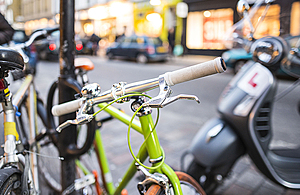 Alternative ways to travel, such as walking and cycling, could relieve the pressure on public transport, as the Department for Transport (DfT) announces a £250 million emergency active travel fund for England, part of the ‘largest ever boost for cyclists and pedestrians.
Alternative ways to travel, such as walking and cycling, could relieve the pressure on public transport, as the Department for Transport (DfT) announces a £250 million emergency active travel fund for England, part of the ‘largest ever boost for cyclists and pedestrians.
image for illustration purposes only UK Government Open Licence v3.0
The DfT writes:
- largest ever boost for cyclists and pedestrians
- emergency bike lanes and streets will help support transport network
- trials of rental e-scooters to be brought forward to increase green transport options
- government working with leading tech developers to reduce crowding on public transport
Far more people will be cycling and walking thanks to plans to boost greener, active transport, launched today (9 May 2020) by Transport Secretary Grant? Shapps?.
Pop-up bike lanes with protected space for cycling, wider pavements, safer junctions, and cycle and bus-only corridors will be created in England within weeks as part of a £250 million emergency active travel fund – the first stage of a £2 billion investment, as part of the £5 billion in new funding announced for cycling and buses in February.
Following unprecedented levels of walking and cycling across the UK during the pandemic, the plans will help encourage more people to choose alternatives to public transport when they need to travel, making healthier habits easier and helping make sure the road, bus and rail networks are ready to respond to future increases in demand.
The government will fund and work with local authorities across the country to help make it easier for people to use bikes to get around – including Greater Manchester, which wants to create 150 miles of protected cycle track, and Transport for London, which plans a “bike Tube” network above Underground lines.
Fast-tracked statutory guidance, published today and effective immediately, will tell councils to reallocate roadspace for significantly-increased numbers of cyclists and pedestrians. In towns and cities, some streets could become bike and bus-only while others remain available for motorists. More side streets could be closed to through traffic, to create low-traffic neighbourhoods and reduce rat-running while maintaining access for vehicles.
Vouchers will be issued for cycle repairs, to encourage people to get their old bikes out of the shed, and plans are being developed for greater provision of bike fixing facilities. Many more will take up the Cycle to Work scheme, which gives employees a discount on a new bike.
Transport Secretary Grant Shapps said:
“During this crisis, millions of people have discovered cycling – whether for exercise or as a means of safe, socially-distanced transport. While there is no change to the ‘stay at home’ message today, when the country does get back to work we need those people to stay on their bikes and be joined by many more.
“Otherwise, with public transport’s capacity severely restricted at this time, our trains and buses could become overcrowded and our roads gridlocked – holding up emergency services, critical workers and vital supplies.
“We know cars will continue to remain vital for many, but as we look to the future we must build a better country with greener travel habits, cleaner air and healthier communities.”
An updated Cycling and Walking Investment Strategy will be launched by the Prime Minister in the summer, with further measures to transform cycling and walking to deliver the government’s aims to double cycling and increase walking by 2025 – including:
-
- the creation of a national cycling and walking commissioner and inspectorate
- higher standards for permanent infrastructure across England
- getting GPs to prescribe cycling and exercise
- creating a long-term budget for cycling and walking similar to what happens for roads
The government will also be launching a campaign to encourage more people to look at alternative ways to travel, to walk or get on a bike for their commute instead of public transport. Today, riders from Team Ineos, including Chris Froome and Geraint Thomas, will be telling people to #GetPedalling…..
The government is also working alongside the tech sector to see how technology could be used to help commuters stagger their journeys and advise on alternative modes of travel.? Leading transport tech experts including Google, Zipabout and Trainline met this week at a roundtable chaired by the Transport Secretary, to explore how technology could help ease overcrowding and reduce the risk of a second spike in coronavirus cases.
Potential solutions could include mobile phone apps warning when public transport is particularly busy or advising on a quieter time to travel, allowing people to flex their hours and prevent the transport network from being overburdened.

